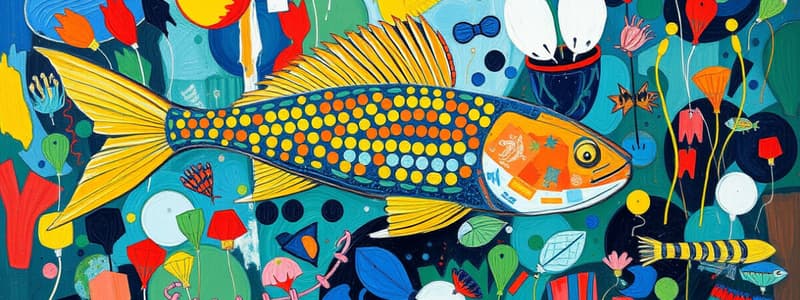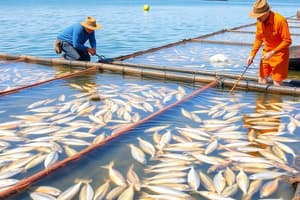Podcast
Questions and Answers
What is the main purpose of aquaculture?
What is the main purpose of aquaculture?
- To create natural habitats.
- To farm aquatic organisms for human consumption. (correct)
- To regulate fish populations in lakes.
- To capture wild fish populations.
Which farming method in aquaculture relies heavily on technology and feeding for increased yields?
Which farming method in aquaculture relies heavily on technology and feeding for increased yields?
- Extensive Aquaculture
- Aquaponics
- Semi-Intensive Aquaculture
- Intensive Aquaculture (correct)
What are Integrated Multi-Trophic Aquaculture (IMTA) systems designed to do?
What are Integrated Multi-Trophic Aquaculture (IMTA) systems designed to do?
- Focus exclusively on shellfish farming.
- Utilize different nutrient levels by combining various species. (correct)
- Maximize water consumption in aquaculture.
- Completely eliminate the need for feed.
Which of the following is a negative environmental impact of aquaculture?
Which of the following is a negative environmental impact of aquaculture?
What is one of the significant economic aspects of aquaculture?
What is one of the significant economic aspects of aquaculture?
Flashcards are hidden until you start studying
Study Notes
Definition
- Aquaculture: The farming of aquatic organisms, including fish, mollusks, crustaceans, and aquatic plants.
Types of Aquaculture
- Marine Aquaculture: Cultivation in ocean environments.
- Freshwater Aquaculture: Cultivation in rivers, lakes, and ponds.
- Brackish Water Aquaculture: Cultivation in estuarine environments.
Farming Methods
- Extensive Aquaculture: Low input; relies on natural productivity.
- Intensive Aquaculture: High input; uses technology and feeding for higher yields.
- Semi-Intensive Aquaculture: Combination of extensive and intensive methods.
Key Species
- Fish: Salmon, tilapia, catfish, trout.
- Shellfish: Shrimp, oysters, clams, mussels.
- Seaweeds: Kelp, nori, dulse.
Environmental Impact
- Positive: Can alleviate pressure on wild fish stocks, promote biodiversity.
- Negative: Pollution, habitat destruction, disease spread, genetic impacts on wild populations.
Economic Aspects
- Significant contributor to global food security.
- Provides livelihood for millions worldwide.
- Growing industry with increasing demand for seafood.
Sustainable Practices
- Integrated Multi-Trophic Aquaculture (IMTA): Combining species to utilize different nutrient levels.
- Use of recirculating aquaculture systems (RAS) to minimize water use and waste.
- Certification programs (e.g., ASC, MSC) to promote sustainable practices.
Challenges
- Disease management and biosecurity.
- Water quality management.
- Climate change impacts (temperature changes, extreme weather).
Regulations
- Varies by country; involves health, environmental, and trade policies.
- Requires licensing and adherence to sustainability practices.
Future Trends
- Increased use of technology (e.g., automation, AI).
- Greater focus on sustainability and reducing environmental impacts.
- Expansion into new species and cultivation methods.
Definition
- Aquaculture involves the farming of various aquatic organisms, including fish, mollusks, crustaceans, and aquatic plants.
Types of Aquaculture
- Marine Aquaculture operates in ocean environments.
- Freshwater Aquaculture takes place in rivers, lakes, and ponds.
- Brackish Water Aquaculture occurs in estuarine areas where freshwater mixes with seawater.
Farming Methods
- Extensive Aquaculture utilizes low input with an emphasis on natural productivity.
- Intensive Aquaculture involves high input, utilizing technology and feeding methods to achieve higher yields.
- Semi-Intensive Aquaculture merges extensive and intensive approaches to optimize productivity.
Key Species
- Fish species include salmon, tilapia, catfish, and trout.
- Shellfish varieties consist of shrimp, oysters, clams, and mussels.
- Seaweeds cultivated include kelp, nori, and dulse.
Environmental Impact
- Positive impacts include reducing pressure on wild fish stocks and promoting biodiversity.
- Negative consequences encompass pollution, habitat destruction, disease proliferation, and genetic effects on wild populations.
Economic Aspects
- Aquaculture plays a crucial role in global food security.
- It provides livelihoods for millions around the world.
- The industry is expanding, driven by increasing seafood demand.
Sustainable Practices
- Integrated Multi-Trophic Aquaculture (IMTA) promotes the cultivation of diverse species that utilize varying nutrient levels.
- Recirculating Aquaculture Systems (RAS) help minimize water consumption and manage waste.
- Certification programs like ASC and MSC advocate for sustainable aquaculture practices.
Challenges
- Managing diseases and implementing biosecurity measures is essential.
- Maintaining water quality is critical for successful aquaculture operations.
- Climate change poses risks like temperature fluctuations and extreme weather.
Regulations
- Aquaculture regulations differ by country, addressing health, environmental concerns, and trade regulations.
- Operations require proper licensing and compliance with sustainability practices.
Future Trends
- Technology use, including automation and artificial intelligence, is expected to increase in aquaculture.
- There is a growing emphasis on sustainability and minimizing environmental damage.
- Expansion into new species and innovative cultivation methods is anticipated.
Studying That Suits You
Use AI to generate personalized quizzes and flashcards to suit your learning preferences.




